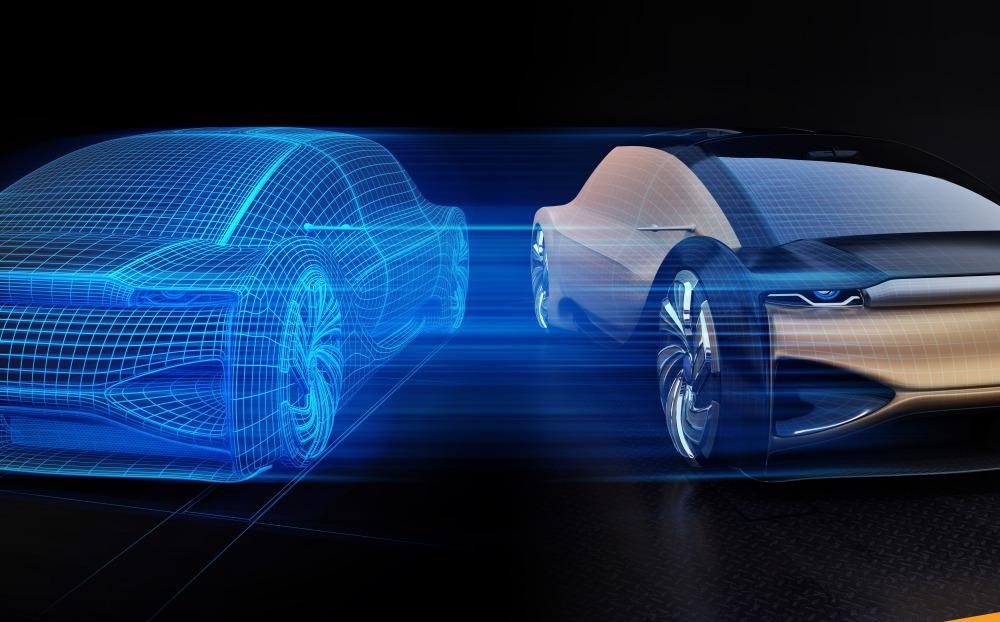
Image Credit: Chesky/Shutterstock.com
Electric vehicles are the future but there is enormous pressure to be innovative and mass-produce cars and trucks that deliver the drive range and performance that is expected, at a low cost, and relatively quickly.
The answer could be digital twin technologies; a bit like a simulator, it is a means of creating a virtual representation of a real-world entity such as a car. The technology is used by manufacturing companies to speed up product development. It acts as a framework that fills the gap between the virtual and physical world to help engineers avoid late technological defects and unexpected performance.
What is Digital Twin Technology?
Digital twin technology represents a new way of thinking about consolidating and coordinating product lifecycle management. The technology has grown in popularity over the past five years as legacy manufacturers seek to keep pace with innovators such as Tesla. It continues to grow along with data integration, artificial intelligence (AI) and the internet of things (IoT), which extend the advantages of digital transformation efforts into the physical world.
Video Credit: IBM Internet of Things/YouTube.com
The technology enables collaboration and improved workflow across different groups – product design, sales, and maintenance for example – and different engineering disciplines. The result is a more efficient design process that allows engineers to develop prototypes faster.
Digital twin technology has been positioned as one of the top five strategic technology trends for 2021 by Accenture, the reason being that “businesses are finally figuring out how to scale these projects across a fleet of projects, rather than a single one-off,” according to Michael Biltz, Accenture Technology Labs managing director.
The technology has been swiftly implemented in many industries and enterprises, commended for its capacity to monitor and streamline data. Several digital twins can be connected to give a network or model of a supply chain, a whole factory, or a place such as a port. Their use can help speed up vehicle electrification, lower construction costs, and aid the design and construction of smart cities.
Use in Vehicle Electrification
Climate change caused by fossil fuel consumption has forced strict environmental regulations to be implemented and consumers are being encouraged to transition to more eco-friendly electric vehicles (EVs). Meanwhile, the use of autonomous vehicles has increased; both these factors have reshaped vehicle engineering processes and methods.
Digital twins allow manufacturers to accumulate, visualize, and put into context data from their physical assets and projects using a digital version. AI lets them act on data and respond in a dynamic way. The technology also allows manufacturers to physically validate components and architecture choices.
Implementing digital twins of hybrid and EVs allows manufacturers to optimize EV performance engineering thus accelerating product design. It also enables them to virtually assess the overall performance of the vehicle’s battery, motor, and power electronics and explore the balance of performance attributes, such as drivability, range, safety, aerodynamics, and thermal and energy management.
e.Go’s Factory of the Future
e.GO is an electric vehicle manufacturer that has been working with telecommunication companies Ericsson and Vodafone to develop the factory of the future. Its factory is powered by connected machines and a private 5G network; each machine gathers and processes data which is sent to the company’s network operation center.
Data powers e.Go’s factory. The digital twin knows everything that is going on and schedules parts to arrive exactly when needed. It also manages tools used by human workers based on current data and specifications to make sure everything is carried out to perfection.
The Future of Digital Twins
Digital twins are unique in that they are not off-the-shelf products. There are different types for different areas – product development, manufacturing, supply chains – meaning extensive customization is necessary to combine all the data. Unlocking its full potential will need seamless integration, alignment, and best practices for hardware and software infrastructure.
But it can be done, with the greatest uptake of digital twin technology in energy and utilities, where it will hasten the switch to renewables and achieving net-zero emissions, and medical and health care, although these face challenges matching digital twins across a mixture of different systems. These early adopters are likely to experience a substantial competitive advantage.
References and Further Reading
Lawton, G. (2021) Why Accenture lists ‘digital twins’ as top-five technology trend in 2021, VentureBeat: https://venturebeat.com/2021/03/12/why-accenture-lists-digital-twins-as-top-five-technology-trend-in-2021/. Accessed 16 April 2021.
Accenture (2021) Technology Vision 2021, Accenture: https://www.accenture.com/us-en/insights/technology/_acnmedia/Thought-Leadership-Assets/PDF-4/Accenture-Tech-Vision-2021-Full-Report.pdf. Accessed 16 April 2021.
Siemens, Adopting a digital twin approach to optimize electrified vehicle performance engineering, Siemens: https://www.plm.automation.siemens.com/global/en/webinar/vehicle-electrification-perform-eng-simulation/42101. Accessed 16 April 2021.
Bahtti, G. (2021), Towards the future of smart electric vehicles: Digital twin technology, Renewable and Sustainable Energy Reviews: https://doi.org/10.1016/j.rser.2021.110801. Accessed 16 April 2021.
e.Go: https://e-go-mobile.com/en. Accessed 16 April 2021.
Disclaimer: The views expressed here are those of the author expressed in their private capacity and do not necessarily represent the views of AZoM.com Limited T/A AZoNetwork the owner and operator of this website. This disclaimer forms part of the Terms and conditions of use of this website.